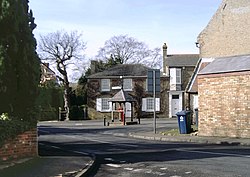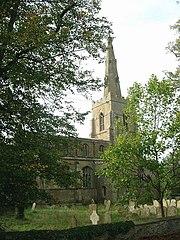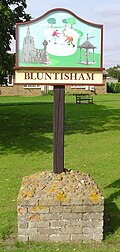Bluntisham
| Bluntisham | |
| Huntingdonshire | |
|---|---|
 Bluntisham | |
| Location | |
| Grid reference: | TL373743 |
| Location: | 52°21’0"N, -0°1’1"E |
| Data | |
| Postcode: | PE28 |
| Local Government | |
| Council: | Huntingdonshire |
Bluntisham is a village in Huntingdonshire. It stands close to the Great Ouse, downstream and northeast from St Ives. The village is bordered on the one side by the fens and on the other by farmland which was once mainly orchards, but has now been turned under the plough.
Earith, with which Bluntisham shares much of its history, lies a little downstream.
It is an attractive, growing village. Walkers and sportsmen may come here; for the former Bluntisham gives access to the Ouse Valley Way and the "Pathfinder" route. Sportsmen may come for the shooting but a short distance away lies Bury Fen, which in winter may freeze over, less so perhaps than in former days: ice skating is the local sport and at Bury Fen ice hockey is reputed to have originated, under its local name of "Bandy". The rules of Bandy were devised here.
The village has two pubs: The White Swan and The Prince of Wales.
The Greenwich Meridian passes through the western edge of Bluntisham.
Name of the village
The village appears in the record as Bluntersham (10th-13th centuries), Blondesham (14th century), Bluntysham, Bluntsome, Blunsham (16th century).
Its neighbour of the parish, Earith, appears as Herhythe, Herhethe (12th century), Herethe, Erehethe, Erhuth (14th century), Earette, Earythe (16th century).
The name Bluntisham-cum-Earith is given to the joint parish of the two villages. While once Earith may have been the smaller partner of the parish, the two are now equals.
Churches
Parish church

The parish church is St Mary's, a fine building of the 13th century, though mainly of the 14th-15th centuries. It has a somewhat usual spire atop its tower, with several windows peeping out. The base of the tower is within the church, with arches from it to the nave and aisles.
St Mary's has a list of Rectors going back to 1217, amongst whom are Henry Sayers, the father of Dorothy Leigh Sayers, author and creator of the Lord Peter Wimsey series. His partial restoration and expansion to a ring of eight bells in 1910 was completed in 2004 when the bells were rehung in a new iron frame. This made full circle ringing possible for the first time for 160 years.
Unusual features of the Church of St Mary are the semi-hexagonal apse, the early sacristy, the provision of a north as well as a south porch. It retains some rare pre-reformation features, including a holy water stoup and painted panels in the screen under the tower, and a few encaustic tiles.
The south aisle communion table is of 17th century origin.
Baptist Church
Bluntisham Baptist Church stands on the High Street.
History

Evidence of Neolithic and Roman inhabitants has been found. However, the four open fields of the old village can still be traced. Higham Field lay in the north-western part of the parish, about 100 feet above sea-level. Gill Field in the south-western part, which gradually slopes down to the River Ouse, takes its name from the 'Gills' or water channels. From Higham Field eastwards, on the north side was Coleway Field, and between that and Bury Fen (which lies below the church) was Old Mill Field or Inhams, which stretched from Bluntisham to Earith.
The two townships of Bluntisham and Earith, which are a mile apart, have probably always formed one ecclesiastical parish with the parish church in Bluntisham and a chapelry in Earith. The usual ecclesiastical name is Bluntisham-cum-Earith, which is no more than Latin for "Bluntisham with Earith". A civil parish shared the name until split in two in 1948.
The soil hereabouts varies: in the gravel areas, fruit trees, barley and oats do well whilst on the loam and clay lands wheat prevails. The water supply traditionally was derived from gravel springs in places; later wells, fed by surface water (called "sock" wells) were used. On the west, near the Somersham road, was a chalybeate spring where more than one attempt was made in the 18th century to establish "Somersham Spa".
The river "port" for the village was neighbouring Earith, which is on a tidal part of the river (remarkably, the Great Ouse is tidal for a mile or so and then ceases to be so: the tide is in the Old Bedford River and New Bedford River and the stretch of the Ouse between them).
Bluntisham's most famous villager is probably Dorothy L Sayers, the popular crime writer. She lived in the village from 1897, when her father became the rector, to 1917. Her novel The Nine Tailors was inspired by her father's restoration of the Bluntisham church bells in 1910.
The village also has the most successful bandy club in British history, the Bury Fen Bandy Club, and indeed its is believed that the sport of bandy was devised here. From this famous club came Charles G Tebbutt, who was responsible for the first published rules of bandy in 1882.
The once quite considerable woodland has almost disappeared. In 1843, there still were 68 acres of woodland but this had shrunk to only 10 acres by 1925, leaving only the names of the woods.
The west end of the parish was part of Somersham Heath, which was enclosed in 1797. There was no road across it before then. This part of the parish is still called Bluntisham Heath. The western end of the village is called Wood End; eastwards was the Colne road where some of the oldest buildings were located. The main part of Bluntisham Village runs straight north and south to the Rectory Corner on the St. Ives road. At this point stood the village pound and a small hamlet known as Little London.
Outside links
| ("Wikimedia Commons" has material about Bluntisham) |
